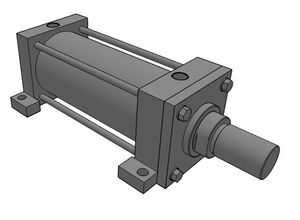Pneumatic Cylinder: Difference between revisions
From DT Online
m (Edited images sizes) |
No edit summary |
||
| Line 10: | Line 10: | ||
The [http://en.wikipedia.org/wiki/Single-_and_double-acting_cylinders '''double acting cylinder'''] | The [http://en.wikipedia.org/wiki/Single-_and_double-acting_cylinders '''double acting cylinder'''] | ||
has two air connections. When compressed air is applied to one connector and the other connector is allowed to exhaust to atmosphere ''(i.e. the air is allowed to escape freely)'', the piston is driven to one end of the cylinder. When air is then applied to the second connector and the first is allowed to exhaust to atmosphere, the piston is driven back. This type of cylinder gives greater power on the return stroke than the single acting cylinder, and also ensures that the piston is effectively locked in position at both ends of its stroke. | has two air connections. When compressed air is applied to one connector and the other connector is allowed to exhaust to atmosphere ''(i.e. the air is allowed to escape freely)'', the piston is driven to one end of the cylinder. When air is then applied to the second connector and the first is allowed to exhaust to atmosphere, the piston is driven back. This type of cylinder gives greater power on the return stroke than the single acting cylinder, and also ensures that the piston is effectively locked in position at both ends of its stroke. | ||
{{Secondary Pneumatics}} | {{Secondary Pneumatics}} | ||
Revision as of 16:57, 22 November 2014
Pneumatic cylinders convert the energy in the compressed air into linear motion. The air enters the cylinder and pushes a piston from one end of the cylinder to the other. There are two main types of cylinder - single acting and double acting. A single acting cylinder has only one air connection, whilst a double acting has two.
In a single acting cylinder, the piston is forced out by the pressure of the air. When the air supply is removed and the air inside the cylinder is allowed to escape, the piston moves back, driven by the force of a spring. By restricting the escaping air (exhaust), it is possible to slow down the return movement of the piston.
The double acting cylinder has two air connections. When compressed air is applied to one connector and the other connector is allowed to exhaust to atmosphere (i.e. the air is allowed to escape freely), the piston is driven to one end of the cylinder. When air is then applied to the second connector and the first is allowed to exhaust to atmosphere, the piston is driven back. This type of cylinder gives greater power on the return stroke than the single acting cylinder, and also ensures that the piston is effectively locked in position at both ends of its stroke.


